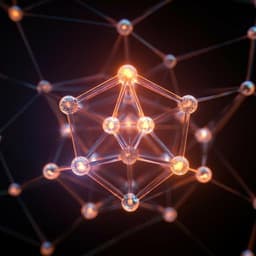
Computer Science
Quantum computational phase transition in combinatorial problems
B. Zhang, A. Sone, et al.
This research by Bingzhi Zhang, Akira Sone, and Quntao Zhuang explores the Quantum Approximate Optimization Algorithm (QAOA) and uncovers a computational phase transition when tackling challenging problems like SAT. They illuminate how QAOA's complexity and circuit controllability contribute to a unique quantum advantage over classical methods, despite certain performance limitations.
~3 min • Beginner • English
Introduction
The paper investigates when and why QAOA exhibits empirical hardness or advantage on combinatorial optimization problems, focusing on SAT and 1-in-k SAT+. Classical random k-SAT exhibits a computational phase transition (hardness peak) at a critical clause-to-variable ratio (problem density), but it is unknown how this translates to QAOA which tackles the optimization (Max-SAT) variants. The authors ask: (1) Does QAOA exhibit a computational (trainability) phase transition versus problem density? (2) How does this relate to classical hardness and to properties of QAOA circuits such as controllability and complexity? (3) In which density regimes might QAOA show accuracy advantages over classical approximate algorithms? They study k=2 and k=3 cases to contrast P vs NP-complete decision versions, noting that all corresponding Max versions are NP-hard. Understanding these aspects is crucial for identifying near-term quantum advantage on practical problems.
Literature Review
Prior work established classical hardness peaks near the SAT-UNSAT transition in random k-SAT and variants (Cheeseman et al.; Mitchell et al.; Achlioptas et al.; Leyton-Brown et al.). For QAOA, Akshay et al. reported performance decay with density termed reachability deficits and observed little difference between Max-2-SAT and Max-3-SAT. Barren plateaus in variational circuits and their dependence on circuit complexity, cost functions, and noise have been studied (McClean et al.; Cerezo et al.; Wang et al.), with connections to unitary t-designs (Dankert et al.; Roberts & Yoshida; Nahum et al.; Zhuang et al.). Controllability via dynamical Lie algebras (DLA) offers diagnostic tools for trainability (D’Alessandro; Wang et al.; Larocca et al.). Quantum adiabatic algorithms (QAA) have exhibited small gaps and phase transitions on SAT-like problems (Farhi et al.; Young et al.; Zhuang). Thresholds for random SAT and 1-in-k SAT+ are known (Goerdt; Kalapala & Moore). Approximation bounds exist for Max-2-SAT and Max-3-SAT (Håstad; de la Vega & Karpinski), while 1-in-k SAT+ can be reduced to MWIS with known greedy approximations (Choi; Lucas; Sakai et al.; Kako et al.).
Methodology
- Problem formulation: Encode SAT (k=2,3) and positive 1-in-k SAT+ (k=2,3) instances as spin Hamiltonians H_c acting on n qubits. For k-SAT: H_c^k = Σ_α ∏_j (1 − A_{αj} σ_z^j), with A_{αj} ∈ {−1,0,+1}. For 1-k-SAT+: H_c^{3+} = (1/4) Σ_α (1 + σ_z^1 + σ_z^2 + σ_z^3 − 1)^2 and H_c^{2+} = (1/2) Σ_α (1 + σ_z^1 + σ_z^2)^2. Map Boolean variables to σ_z eigenstates (true→|1⟩, false→|0⟩). A satisfied instance has ground-state energy zero. QAOA uses mixing Hamiltonian H_m = Σ_i σ_x^i.
- QAOA setup: p-layer unitary U_QAOA = ∏_{j=1}^p e^{-i β_j H_m} e^{-i γ_j H_c} acting on |+⟩^{⊗n}. Minimize cost C(γ,β) = ⟨Ψ(γ,β)| H_c |Ψ(γ,β)⟩.
- Trainability metric: Evaluate gradients via finite differences at random parameters (γ,β) drawn uniformly (γ_l ∈ [0,2π), β_l ∈ [0,π)), compute SD of ∂_{γ1} C over random choices and instances; plot 1/SD to indicate hardness. Study dependence on clause-to-variable ratio m/n, layer depth p, and n. Examine gradient scaling (barren plateau) by comparing SD across n (ratios for n=6 vs n=16 or 18) and by SD versus p for various fixed m/n and n.
- Controllability analysis: Compute the dimension of dynamical Lie algebra dim(g) generated by {i H_c, i H_m} numerically (costly, so mainly n=6) versus m/n. Use theoretical relation 1/SD(∂_γ C) ∈ Ω([poly(dim(g))]^{1/2}). Provide bounds at symmetric limit m≈n for 1-k-SAT+: dim(g) bounded above by n(n^2+6n+11) and expected ≥ n^2 (nearest-neighbor Ising) (proof in Methods/Supplementary).
- Circuit complexity: Evaluate ensemble-averaged infinite-temperature 4-point OTOC C_OTO(σ_i^z, σ_j^z; U_p) for the QAOA ensemble U_p to assess closeness to a unitary 2-design (Haar value d/(d^2−1), d=2^n). Study OTOC versus m/n and p.
- Accuracy evaluation: For each instance, run QAOA with heuristic pre-optimization initialization (details in Supplementary) and perform 10 repetitions; take the best result. Compute expected approximation ratio r (expected number of satisfied clauses divided by the maximum possible). For k-SAT compare with classical lower bounds (Max-3-SAT r≥0.95; Max-2-SAT r≥21/22). For 1-k-SAT+, reduce to maximum weighted independent set (MWIS) and compare with greedy MWIS approximations (best of several heuristics). Also recast optimization results into decision SAT/UNSAT via a threshold on expected UNSAT clauses (E_th=0.5) and compute success probability versus m/n.
- QAA comparison: Use linear interpolation H(s)= s H_c + (1−s) H_g, with H_g = Σ_i h_i (h_i counts occurrences of variable v_i). Simulate n≈10 instances with QuTiP. Compute minimum spectral gap ΔE across s and use 1/ΔE^2 as hardness proxy. Simulate finite-time evolution with total time T_0 ∈ {10,20,50,100} (arb. units) and compute probability P of ending in the ground-state manifold. Analyze versus m/n and SAT/UNSAT classes.
- Datasets and averaging: Random instances generated uniformly by selecting m clauses over n variables, k literals per clause (signs random for k-SAT; positive-only for 1-in-k). Explore n up to 16 (k-SAT) and 18 (1-k-SAT+) for gradients; n=10 for OTOC; n=6 for DLA; aggregate statistics over 100 random instances per point; various p up to 128 depending on figure.
Key Findings
- Trainability phase transition: The inverse gradient SD 1/SD(∂_{γ1} C) exhibits a clear peak at a critical clause-to-variable ratio m/n, indicating minimal typical gradient (hardest training) at that density. This quantum critical density generally deviates from the classical SAT-UNSAT threshold, except in 1-3-SAT+ where they coincide.
- Controllability linkage: The DLA dimension dim(g) versus m/n mirrors the inverse-gradient behavior, confirming a connection between reduced controllability (smaller dim(g)) and larger gradients (easier training), and vice versa. Bounds at symmetric limit m≈n indicate polynomial dim(g) (≤ n(n^2+6n+11)), implying gradients are only polynomially small at high density.
- Barren plateaus and complexity: Evidence of barren plateaus emerges near and above the critical density—gradient SD decays exponentially with n at sufficiently large p for 1-3-SAT+ around the transition, while for 1-2-SAT+ barren plateaus appear only at larger m/n. Ratios of gradient variances across sizes saturate beyond the peak, consistent with barren plateau behavior. OTOC decays toward the Haar 2-design value near the critical density, especially for k=3, indicating increased circuit complexity (approach to 2-design) coincident with trainability transition.
- Accuracy robustness and quantum advantage: QAOA’s approximation ratio r decreases slowly with m/n and improves with p. For Max-3-SAT and Max-2-SAT, even shallow circuits surpass classical lower bounds (r≈0.95 for random Max-3-SAT; r≥21/22 for Max-2-SAT). For Max-1-3-SAT+ and Max-1-2-SAT+, QAOA outperforms greedy MWIS approximations at larger densities (quantum advantage around p≈16 for 1-3-SAT+, and already at p=8 for 1-2-SAT+). Across cases, Max-2-SAT tends to perform slightly better than Max-3-SAT; similarly, 1-2-SAT+ outperforms 1-3-SAT+ at fixed p.
- Decision performance and classical hardness remnant: Converting optimization outcomes to SAT/UNSAT decisions reveals a dip in success probability near the classical SAT-UNSAT threshold for k=3 problems; this dip diminishes with depth and is nearly absent for k=2 at p=16, indicating remnant classical empirical hardness in decision tasks distinct from the trainability transition.
- QAA comparison: For 3-SAT and 1-3-SAT+, the minimum gap is smallest near the classical threshold, implying maximal hardness; for 2-SAT and 1-2-SAT+, gaps are larger beyond the threshold. Finite-time success probabilities of QAA decrease before the critical point and remain comparatively robust above it, aligning with QAOA’s slow decay of r at higher densities. All statistics are averaged over 100 random instances; sizes include n up to 18 for gradients and n=10 for OTOC/QAA.
Discussion
The study demonstrates that QAOA exhibits a computational trainability transition as a function of problem density that is distinct from the classical SAT-UNSAT transition. This transition corresponds to minimal typical gradients and aligns with reduced controllability (smaller DLA dimension) and heightened circuit complexity (approach to unitary 2-design as seen via OTOC). Consequently, training is hardest around this critical quantum density, even when classical hardness may peak elsewhere. Despite reachability deficits at large densities, QAOA’s approximation ratio degrades slowly with m/n, and precisely in high-density regimes QAOA can surpass classical approximation heuristics, revealing practical avenues for quantum advantage on hard instances. Furthermore, when QAOA outputs are interpreted for decision tasks, a valley in success probability appears near the classical threshold for k=3, echoing classical empirical hardness—highlighting a dichotomy between trainability transitions and decision-task hardness. Comparisons with QAA reinforce these insights: QAA’s minimal gaps and performance trends track the classical transition for k=3 problems, while both QAOA and QAA show robustness at high density. The results collectively clarify how controllability and complexity shape QAOA’s landscape and where advantage can arise.
Conclusion
The paper identifies and explains a quantum computational phase transition in QAOA training for SAT-type problems: typical gradients are minimized at a critical problem density that generally differs from the classical SAT-UNSAT transition. This trainability transition is linked to controllability (DLA dimension) and circuit complexity (approach to 2-design), providing mechanistic insight into barren plateaus. Performance-wise, QAOA maintains robust approximation ratios that decay slowly with density and can outperform classical approximation algorithms for high-density instances, especially in Max-1-k-SAT+. Decision-task performance retains signatures of classical hardness near the SAT-UNSAT threshold for k=3. The authors anticipate these phenomena to generalize across NP-complete combinatorial optimization problems where clause-to-variable ratio serves as a universal problem-density metric. Future work could pursue analytical characterizations of the transitions, scaling studies at larger n, improved training strategies to mitigate barren plateaus, and broader benchmarks against stronger classical algorithms and on real quantum hardware.
Limitations
- Empirical nature: Results are based on numerical experiments; analytical proofs are challenging and not provided.
- Finite sizes: Simulations use relatively small n (e.g., gradients up to n=18; OTOC at n=10; DLA at n=6 due to computational cost), so finite-size effects may cause deviations (e.g., from exact threshold locations).
- Gradient estimation: Gradients are evaluated via finite differences at random parameters; conclusions about typical training landscapes may depend on parameter sampling and initialization heuristics.
- DLA approximations: Only small systems are used to compute dim(g); symmetric-limit bounds are loose and serve as guidance rather than tight characterizations.
- QAA time proxy: The runtime estimate 1/ΔE^2 is an approximate proxy (more rigorous higher-order bounds exist); finite-time evolutions use fixed schedules and limited T_0.
- Algorithmic benchmarks: Classical comparisons for 1-in-k SAT+ use greedy MWIS heuristics; stronger classical methods might narrow gaps. For Max-k-SAT, comparisons rely on known lower bounds rather than full-fledged state-of-the-art solvers.
- Noise and hardware effects: Results are noiseless simulations; real-device noise and connectivity constraints are not modeled explicitly.
Related Publications
Explore these studies to deepen your understanding of the subject.







